Stainless steel for knives is a wide range of alloys that combine corrosion resistance with various properties that make them suitable for the manufacture of knives, blades, blades for various purposes.
When manufacturing or choosing (buying) knives and blades, manufacturers and consumers often hesitate as to which is better: stainless steel or high-carbon steel. Stainless steel is a good alternative to high-carbon steel, as it is very strong, and knives made of this material maintain a sharp edge for a long time. When it comes to comparing stainless steel and carbon steel knives, the advantage of stainless steel is that it is resistant to corrosion.
Choosing a grade of stainless steel for knives
Choosing the best grade of stainless steel for your knife depends on its purpose and your personal or customer needs. Factors to consider when choosing:
- Hardness: the hardness of steel is measured on the Rockwell scale (HRC) or an alternative scale. Harder stainless steels (60+ HRC) retain their sharpness better, but are more difficult to sharpen and are more brittle.
- Corrosion resistance: some stainless steels are more resistant to corrosion than others. Therefore, pay attention to the content of chromium and other important chemical elements in its composition. This is important if you will use the knife in wet conditions.
- Ability to hold sharpness: some steels hold their sharpness longer than others. This is important if you use the knife often.
- Ease of sharpening: some steels or stainless alloys are easier to sharpen than others. This is important if you plan to sharpen the knife yourself.
- Price: premium stainless steel knives and blades tend to be more expensive.
Stainless Knife Steel VS Carbon Steel
Choosing between stainless steel and carbon steel can be difficult, as each type has its own advantages and disadvantages. Here's a quick overview to help you decide:
Carbon steel:
Advantages:
- Sharpens easily: due to its microstructure, carbon steel is easy to sharpen, keeping a sharp edge for a long time.
- Keeps sharp: carbon steel knives stay sharp for a long time.
- Strength: carbon steel blades are strong and chip resistant.
Disadvantages:
- Prone to rust: carbon steel is not resistant to corrosion, so it needs careful maintenance (wiping dry after use and oiling).
- Spotting: over time, dark spots (patina) may appear on the blade, which do not affect performance, but may not have an aesthetic appearance.
- Difficulty in maintenance: carbon steel knives require more attention and care compared to stainless steel knives.
Stainless steel:
Advantages:
- Corrosion resistance: stainless steel does not rust, so it does not need to be thoroughly dried after use.
- Ease of care: stainless steel knives are easy to care for and can be washed in the dishwasher.
- Preservation of appearance: stainless steel blades do not tarnish over time and do not stain.
- Wide choice: there are many grades of stainless steel with different characteristics, giving a wide choice of knives for different tasks.
Disadvantages:
- Difficulty of sharpening: stainless steel knives are more difficult to sharpen than carbon knives, and they (depending on the selected brand and the correct hardening / heat treatment) may not hold sharpness for as long.
- Strength: stainless steel (depending on the brand chosen and the correct hardening / heat treatment) can be less strong and resistant to chipping than carbon steel, but this is not always the case.
In conclusion:
Choosing between a carbon steel and stainless steel knife depends on your individual needs and preferences.
- If you need a knife with the sharpest edge that lasts for a long time, and you are willing to put in the effort to maintain it, then a carbon steel knife is the best choice.
- If you want a knife that won't rust, is easy to maintain, and is stain resistant, a stainless steel knife is a more practical option.
Popular brands of stainless steel for making knives and blades
- M390: austrian premium grade steel with high hardness, corrosion resistance and cutting edge durability. Its processing complexity makes knives made of this steel more expensive.
- Elmax: swedish steel with excellent chipping resistance and good sharpness retention. It is slightly less solid than the M390, but also more affordable.
- CPM S30V: american steel offering a balance of hardness, corrosion resistance and sharpness retention. It is widely used for its versatility and affordability.
- VG-10: high carbon Japanese steel for excellent cutting edge and corrosion resistance. It is easier to sharpen than M390 or Elmax.
- AISI 440C: a popular American steel that offers good hardness, corrosion resistance, and affordability. It is a popular choice for general purpose knives.
What is the optimal hardness of stainless steel for knives ?
The optimal hardness of stainless steel for a knife depends on its type and purpose. Here are general recommendations:
- Knife type:
- Kitchen Knives: 56-58 HRC provides a good balance between hardness, abrasion resistance and ease of sharpening.
- Hunting and camping knives: 58-60 HRC offer better resistance to chipping and wear, making them more durable in the field.
- Survival and tactical knives: 58-62 HRC. Maximum hardness for maximum strength and chip resistance. It is important to remember that such knives are more difficult to sharpen and they can be more fragile.
- Specialty knives: the hardness of stainless steel can vary depending on the specific application. For example, razor blades usually have a hardness of 60-65 HRC.
- Fillet knives: 54-56 HRC provide flexibility and sharpness retention, which is important for delicate cutting.
- Steel composition:
- Martensitic steels: usually have a hardness of 55-62 HRC. Known for wear resistance and good corrosion resistance.
- Steels with a high chromium content: usually have a hardness of 50-55 HRC. More resistant to corrosion, but less hard.
- Carbon steels: usually have a hardness of 58-62 HRC. They are very hard and keep their sharpness for a long time, but they are prone to corrosion.
- Powder steels: have very high strength and hardness up to 67-70 HRC and, at the same time, have increased resistance to corrosion.
It is important to note:
- Hardness is only one of the factors that determine the quality of a knife.
- Characteristics such as strength, elasticity, flexibility, corrosion resistance and ease of sharpening are also important.
- Different manufacturers may use different heat treatment methods to achieve a certain hardness of stainless steel.
Chemical composition of stainless steel and alloys for knives
The chemical composition of knife steel (knife stainless steel) must be balanced, not overalloyed and accurate. The specification tolerance must be tight to ensure high consistent quality of the finished knife.
The most common chemical elements of knife steel:
- Carbon (C): the main factor in hardness. However, too much carbon makes it difficult to produce martensite from the material, so deep freezing is necessary to achieve high hardness. Hardness is related to the amount of carbon dissolved in the steel matrix. By binding chromium into carbides, carbon indirectly reduces corrosion resistance.
- Chromium (Cr): the main factor in corrosion resistance. The achieved corrosion resistance depends on the amount of Cr dissolved in the steel matrix and is not related to the nominal composition. Cr is also a major factor in carbide formation.
- Molybdenum (Mo): promotes carbide formation and has a small effect on the hardness and corrosion resistance of martensitic stainless grades.
- Vanadium (V): strong carbide former. Vanadium carbides are also very stable and do not dissolve during heat treatment.
- Nitrogen (N): A hardness factor like carbon, but does not have the same negative effect on corrosion resistance. Nitrogen is not normally used in these applications because it is difficult to achieve significant levels of nitrogen in traditional steelmaking.
- Sulfur (S): forms sulphide inclusions that adversely affect the initiation of pitting.
- Manganese (Mn), phosphorus (P) and silicon (Si): these elements do not contribute significantly. A general rule of thumb is to keep them as low as possible in the knife steel composition.
The most important thing to remember is that the hardness and corrosion resistance of stainless steel for knives is related to the composition of the matrix after hardening, and not to the nominal chemical composition of the steel. Excessive amounts of these elements form large primary carbides during casting and will not add hardness or corrosion resistance to the finished knife.
Primary carbides make the knife more brittle and harder to sharpen than a fine-grained steel knife of the same hardness. Steels containing large primary carbides will also cause very high wear on the stamping tools, making them unsuitable for stamping.
| Grade | Chemical composition, % | ||||||||||||||
| C ↓ | Cr ↓ | Mo ↓ | W ↓ | V ↓ | Mn ↓ | Nb ↓ | Si ↓ | Ni ↓ | P ↓ | Cu ↓ | S ↓ | Co ↓ | N ↓ | Fe ↓ | |
| M398 | 2.7 | 20.0 | 1.0 | 0.7 | 7.2 | 0.5 | - | 0.5 | - | - | - | - | - | - | Other |
| M390 | 1.9 | 20.0 | 1.0 | 0.6 | 4.0 | 0.3 | - | 0.7 | - | - | - | - | - | - | Other |
| N695 | 0.95-1.2 | 16.0-18.0 | 0.65 | - | - | 1.0 | - | 1.0 | 0.75 | 0.05 | 0.5 | 0.03 | - | - | Other |
| N690 | 1.08 | 17.3 | 1.1 | - | 0.1 | 0.4 | - | 0.4 | - | - | - | - | 1.5 | - | Other |
| N685 | 0.9 | 17.5 | 1.1 | - | 0.1 | 0.4 | - | 0.45 | - | - | - | - | - | - | Other |
| CTS BD1 | 0.85-0.95 | 15.0-17.0 | 0.5 | - | - | 1.0 | - | 1.0 | - | 0.04 | - | 0.03 | - | - | Other |
| CTS BD1N | 0.85-0.95 | 15.0-17.0 | 0.5 | - | - | 1.0 | - | 1.0 | - | 0.03 | - | 0.01 | - | 0.10-0.15 | Other |
| CTS 204P | 1.9 | 20.0 | 1.0 | 0.65 | 4.0 | 0.35 | - | 0.6 | - | - | - | - | - | - | Other |
| CTS XHP | 1.6 | 16.0 | 0.8 | - | 0.45 | 0.5 | - | 0.4 | 0.35 | - | - | - | - | - | Other |
| Vanax SuperClean | 0.36 | 18.2 | 1.1 | 0.06 | 3.5 | 0.3 | - | 0.3 | 0.18 | 0.19 | 0.09 | 0.01 | 0.05 | 1.55 | Other |
| Elmax | 1.7 | 18.0 | 1.0 | 0.11 | 3.0 | 0.35 | - | 0.8 | 0.15 | - | - | - | - | - | Other |
| CPM MagnaMax | 2.04 | 10.65 | 2.0 | - | 8.0 | 0.5 | 2.5 | - | 0.2 | - | - | - | 0.8 | - | Other |
| CPM MagnaCut | 1.45 | 10.7 | 2.0 | - | 4.0 | 0.5 | 2.0 | 0.4 | - | - | - | - | - | 0.2 | Other |
| CPM MPL-1 | 3.75-3.80 | 24.0-24.2 | 3.0 | 0.4 | 9.0-9.1 | 0.45-0.50 | - | 0.5 | - | 0.015 | - | 0.015 | - | - | Other |
| CPM S125V | 3.3 | 14.0 | 2.5 | - | 12.0 | 0.5 | - | 0.9 | - | - | - | - | - | - | Other |
| CPM S110V | 2.8-2.9 | 14.0-15.3 | 2.25 | - | 9.0 | 0.4 | 3.0 | 0.6 | - | - | - | - | 2.5 | - | Other |
| CPM S90V | 2.3 | 14.0 | 1.0 | - | 9.0 | 0.4 | - | 0.4 | - | - | - | - | - | - | Other |
| CPM S60V | 2.15 | 17.0 | 0.4 | 0.4 | 5.5 | 0.4 | - | 0.4 | - | - | - | - | - | - | Other |
| CPM S45VN | 1.48 | 16.0 | 2.0 | - | 3.0 | - | 0.5 | - | - | - | - | - | - | 0.15 | Other |
| CPM S35VN | 1.4 | 14.0 | 2.0 | 0.5 | 3.0 | 0.5 | 0.5 | 0.4 | 0.4 | 0.03 | - | 0.03 | 0.5 | - | Other |
| CPM S30V | 1.45 | 14.0 | 2.0 | 0.4 | 4.0 | 0.5 | - | 0.5 | - | 0.03 | - | - | 1.0 | 0.5 | Other |
| CPM SPY27 | 1.25 | 14.0 | 2.0 | - | 2.0 | 0.5 | 1.0 | 0.5 | - | - | - | - | 1.5 | 0.1 | Other |
| CPM 20CV | 1.9 | 20.0 | 1.0 | 0.6 | 4.0 | 0.3 | - | 0.3 | - | - | - | - | - | - | Other |
| CPM 154 (154 CM) | 1.05 | 14.0 | 4.0 | 0.4 | 0.4 | 0.5 | - | 0.8 | - | 0.03 | - | 0.03 | - | - | Other |
| CPM D2 | 1.54 | 11.3 | 0.76 | - | 0.92 | 0.31 | - | 0.81 | - | 0.016 | - | 0.014 | - | - | Other |
| RWL-34 | 1.05 | 14.0 | 4.0 | - | 0.2 | 0.5 | - | 0.5 | - | - | - | - | - | - | Other |
| SG2 | 1.4 | 15.0 | - | - | 1.8-2.2 | 0.4 | - | 0.5 | 0.15 | 0.03 | 0.3 | 0.03 | - | - | Other |
| SPG STRIX | - | - | - | - | - | - | - | - | - | - | - | - | - | - | Other |
| VG-10 | 0.95-1.05 | 14.5-15.5 | 0.9-1.2 | - | 0.2-0.3 | - | - | 0.6 | - | 0.03 | - | - | 1.3-1.8 | - | Other |
| VG-10W | 1.0 | 15.0 | 1.0 | 0.4 | 0.25 | - | - | - | - | - | - | - | 1.55 | - | Other |
| ZDP-189 | 3.0 | 20.0 | 1.4 | 0.6 | 0.1 | 0.5 | - | 0.4 | - | - | - | - | - | - | Other |
| ATS-34 | 1.05 | 14.0 | 4.0 | - | - | 0.4 | - | 0.35 | 0.3 | 0.03 | - | 0.02 | - | - | Other |
| ATS-55 | 1.0 | 14.0 | 0.6 | - | - | 0.5 | - | 0.35 | - | 0.03 | 0.2 | - | 0.4 | - | Other |
| AUS-8 | 0.7-0.75 | 13.0-14.5 | 0.1-0.3 | - | 0.1-0.26 | 0.5 | - | 1.0 | 0.5 | 0.04 | - | 0.03 | - | - | Other |
| AUS-10A | 0.95-1.1 | 13.0-14.5 | 0.1-0.31 | - | 0.1-0.27 | 0.5 | - | 1.0 | 0.49 | 0.04 | - | 0.03 | - | - | Other |
| AISI 440C | 0.95-1.2 | 16.0-18.0 | <0.75 | - | - | <1.0 | - | <1.0 | <1.0 | <0.04 | - | <0.03 | - | - | Other |
| MA5 | 0.35 | 16.0 | - | - | - | 0.35 | - | 0.35 | - | - | - | - | - | 0.15 | Other |
| Nitro-V | 0.68 | 13.5 | - | - | 0.1 | 0.45 | - | 0.35 | - | 0.01 | - | 0.001 | - | 0.12 | Other |
| PMD550 | 2.66 | 17.0 | 1.8 | - | 3.3 | - | - | - | - | - | - | - | 2.0 | - | Other |
Hardness of stainless steel and alloys for knives
The hardness of stainless steel and alloys for knives is usually measured on the Rockwell scale (HRC) and is one of the most important indicators of blade quality. It determines the steel's ability to hold a sharp cutting edge and its wear resistance, but at the same time affects its brittleness and the difficulty of sharpening.
The influence of hardness on knife properties
- Higher Hardness (60+ HRC):
- Advantages: holds a sharp edge better and longer, higher wear resistance.
- Disadvantages: harder to sharpen, higher likelihood of brittleness (chipping of the cutting edge).
- Lower Hardness (54 - 58 HRC):
- Advantages: easier to sharpen, higher toughness and resistance to breaking and bending.
- Disadvantages: loses sharpness faster, requires more frequent sharpening.
Steel hardness largely depends on the content of Carbon (C) and quality heat treatment (quenching). Chromium (Cr) provides corrosion resistance (if its content is ≥11.5%).
For kitchen and everyday carry (EDC) knives, a balance in the 57 - 60 HRC range is usually sought, as this allows the knife to be tough enough and easy to sharpen at the same time. For specialized tools, such as survival blades or high-end Japanese knives, steels with a hardness of 62 - 64 HRC may be chosen, sacrificing toughness for extreme sharpness and its long retention.
| Hardness | ||||
| Grade | Soft annealing | After hardening | ||
| max. HB | max. HRC | max. HB | max. HRC | |
| M398 | 330 | 35 | 670 | 64 |
| M390 | 280 | 29 | 630 | 62 |
| N695 | 285 | 29 | 614 | 60 |
| N690 | 285 | 29 | 650 | 63 |
| N685 | 265 | 27 | 590 | 59 |
| CTC BD1 | 240 | 22 | 614 | 60 |
| CTS BD1N | 255 | 25 | 650 | 63 |
| CTS 204P | 290 | 30 | 650 | 63 |
| CTS XHP | 255 | 25 | 670 | 64 |
| Vanax SuperClean | - | - | 620 | 61 |
| Elmax | 280 | 29 | 630 | 62 |
| CPM MagnaMax | - | - | 680 | 65 |
| CPM MagnaCut | 240 | 22 | 680 | 65 |
| CPM MPL-1 | 390 | 42 | 720 | 67 |
| CPM S125V | 280 | 29 | 680 | 65 |
| CPM S110V | - | - | 670 | 64 |
| CPM S90V | 280 | 29 | 614 | 60 |
| CPM S60V | - | - | 570 | 58 |
| CPM S45VN | 255 | 23 | 630 | 62 |
| CPM S35VN | 255 | 23 | 670 | 64 |
| CPM S30V | 255 | 23 | 630 | 62 |
| CPM 20CV | 280 | 29 | 650 | 63 |
| CPM 154 (154 CM) | 240 | 22 | 630 | 62 |
| CPM D2 | - | - | 650 | 63 |
| RWL-34 | 280 | 28 | 670 | 64 |
| SG2 | - | - | 630 | 62 |
| SPG STRIX | - | - | 680 | 65 |
| VG-10 | - | - | 630 | 62 |
| VG-10W | - | - | 630 | 62 |
| ZDP-189 | - | - | 770 | 70 |
| ATS-34 | - | - | 620 | 61 |
| ATS-55 | - | - | 630 | 62 |
| AUS-8 | - | - | 590 | 59 |
| AUS-10A | - | - | 614 | 60 |
| AISI 440C | 270 | 27 | 614 | 60 |
| MA5 | - | - | 630 | 62 |
| Nitro-V | - | - | 670 | 64 |
| PMD550 | 330 | 35 | 650 | 63 |
Physical properties of stainless steel for knives, blades
The physical properties of stainless steel for knives are determined by three critically important characteristics that ensure a balance between the cutting qualities and the durability of the blade: corrosion resistance, wear resistance, and toughness (ductility/impact resistance).
1. Corrosion resistance
This is the steel's ability to resist rusting and oxidation from moisture, salt, and acids. This is the defining advantage of "stainless" steel over carbon steels. The resistance is provided by a high content of Chromium (Cr) (minimum 11.5%), which forms a protective passive film on the blade's surface. This property is critical for kitchen, fishing and diving knives, but it has a compromise: an excess of Carbon (C) can bind chromium into carbides, reducing the effectiveness of the protective film.
2. Wear resistance
Wear resistance is the steel's resistance to abrasive wear during cutting. It directly influences the duration of edge retention. This index is achieved thanks to the presence of hard carbides in the metallic matrix. These carbides are formed with the help of alloying elements such as Carbon (C), Vanadium (V), Chromium (Cr), and Molybdenum (Mo). Knives with high wear resistance are ideal for intensive work with hard or fibrous materials, as they require significantly less frequent sharpening.
3. Toughness / impact resistance
Toughness is the material's ability to absorb impact energy without fracturing, i.e., its resistance to chipping, cracking, and breaking. High toughness is necessary for survival, tactical and large knives used for chopping or subjected to strong lateral loads. This property is opposite to hardness: the higher the blade's hardness (especially ≥62 HRC), the more brittle it is. Modern powdered steels partially solve this problem, providing high hardness with an acceptable level of toughness thanks to the uniform distribution of micro-carbides.
| Physical properties | ||||
| Grade | Density Kg/dm³ | Thermal conductivity W/(m.K) | Specific heat capacity J/(kg.K) | The modulus of elasticity is 10³N/mm² |
| M398 | 7.46 | 15.2 | 490 | 231 |
| M390 | 7.54 | 16.5 | 480 | 227 |
| N695 | 7.70 | 15.0 | 430 | 215 |
| N690 | 7.70 | 15.0 | 430 | 223 |
| N685 | 7.70 | 15.0 | 430 | 215 |
| CTS BD1 | 7.65 | - | 460 | - |
| CTS BD1N | 7.75 | - | - | - |
| CTS 204P | 7.61 | 14.0 | - | 214 |
| CTS XHP | 7.62 | - | - | - |
| Vanax SuperClean | 7.56 | - | 490 | 220 |
| Elmax | 7.60 | 15.2 | 460 | 230 |
| CPM MagnaMax | - | - | - | - |
| CPM MagnaCut | 7.76 | - | - | 215 |
| CPM MPL-1 | - | - | - | - |
| CPM S125V | 7.31 | - | - | 221 |
| CPM S110V | - | - | - | - |
| CPM S90V | 7.40 | - | - | 215 |
| CPM S60V | - | - | - | - |
| CPM S45VN | 7.47 | - | - | 221 |
| CPM S35VN | 7.47 | - | - | 221 |
| CPM S30V | 7.47 | - | - | 221 |
| CPM 20CV | 7.62 | - | - | 214 |
| CPM 154 (154 CM) | 7.78 | 15.0 | 430 | 207 |
| CPM D2 | 7.78 | - | - | 207 |
| RWL-34 | 7.80 | 15.0 | 460 | 200 |
| SG2 | - | - | - | - |
| SPG STRIX | - | - | - | - |
| VG-10 | - | - | - | - |
| VG-10W | - | - | - | - |
| ZDP-189 | - | - | - | - |
| ATS-34 | - | - | - | - |
| ATS-55 | - | - | - | - |
| AUS-8 | - | - | - | - |
| AUS-10A | - | - | - | - |
| AISI 440C | 7.70 | 15.0 | 430 | 200 |
| MA5 | 7.7 | - | 460 | 215 |
| Nitro-V | - | - | - | - |
| PMD550 | - | 19.1 | - | - |
Heat treatment (hardening) of stainless steel for knives
Hardening is a way to make knife steel harder. If you first heat knife stainless steel to a certain temperature (depending on the grade of steel) and then cool (harden) it quickly, the knife steel will become much harder, but also more brittle.
Heat treatment, namely tempering, plays an important role in giving a stainless steel knife the desired properties such as hardness, strength, flexibility and corrosion resistance.
The process of hardening stainless steel for knives consists of several stages:
1. Heating:
- Stainless steel is heated to a certain temperature, which is usually in the range of 980 - 1150 °C, depending on the specific type of steel.
- This temperature is above the critical point at which the austenitic structure of the steel turns into a martensitic one.
2. Soaking:
- The steel is held at this high temperature for a certain amount of time to ensure complete structural transformation.
- Soaking time may vary depending on the size and thickness of the blade..
3. Cooling:
- Rapid cooling of the blade is a key step in the hardening process.
- Usually the blade is immersed in a bath of oil or water.
- Rapid cooling "freezes" the martensitic structure, which leads to a significant increase in hardness and strength.
4. Tempering:
- Tempering is an additional heat treatment process that is performed after quenching to relieve internal stresses and improve the toughness of the stainless steel.
- The blade is heated to a lower temperature (usually 300 - 500 °C) for a certain amount of time and then slowly cooled.
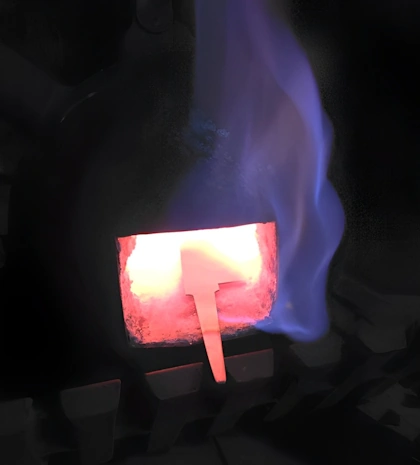
To reduce brittleness, the material is tempered, typically by heating it to 175 - 350 °C for 2 hours, resulting in a hardness of 53 - 63 HRC (depending on the stainless steel grade selected) and a good balance between sharpness retention and grinding ability and strength.
Tempering should be done within a reasonable time after curing, preferably within an hour or so. It is very important that the blade cools to room temperature before tempering begins. Otherwise, the transformation to martensite will be interrupted and the hardening results may be degraded.
A higher tempering temperature will result in a slightly softer material with a higher viscosity, while a lower tempering temperature will produce a harder and slightly more brittle material.
For example, a camping or survival knife can be hardened at 350 °C to withstand rough handling and not break. On the other hand, if the knife is expected to have a sharp edge, it can be hardened at 175 °C to achieve maximum hardness.
Tempering temperatures below 175 °C should only be used in exceptional cases where extreme demands are placed on high hardness, as very low tempering temperatures will result in a very brittle material. Tempering temperatures above 350 °C should also be avoided, as this can lead to brittleness and reduced corrosion resistance. Please note that if a hardened blade is exposed to temperatures above the hardening temperature (e.g. grinding, polishing), the properties of the knife will also be impaired.
It is important to note that the exact parameters of the heat treatment, such as temperature, holding time and cooling rate, must be carefully selected for the specific type of stainless steel from which the knife blade is made.
Proper tempering will result in a good balance between hardness, strength and corrosion resistance in the finished knife blade.
Improper heat treatment can result in the blade being too brittle and prone to chipping, or too soft and not holding its sharpness.
What is the best stainless steel for knives ?
Unfortunately, today, there is no single answer to the question of the best stainless steel for knives, because it depends on your needs and preferences. Different types of stainless steel have different characteristics, so it's important to choose the one that best suits how you will use the knife and under what conditions.
Here are some factors to consider when choosing a knife steel:
- Hardness: the hardness of stainless steel determines how resistant it is to abrasion and chipping. Harder steel will hold an edge longer, but it will also be more difficult to sharpen.
- Wear resistance: is the ability of stainless steel to resist damage caused by both abrasive and adhesive wear. Abrasive wear occurs when harder particles pass through a softer surface. Adhesive wear occurs when debris is displaced from one surface and attached to another. Wear resistance is usually correlated with the hardness of the steel, but is also highly dependent on the specific chemical composition of the stainless steel. In steels of equal hardness, the steel with larger carbides (microscopic, hard, wear-resistant particles) usually resists wear better. However, carbides can become brittle and crack, resulting in reduced strength. Molybdenum and manganese: the blade is stronger and more resistant to abrasion.
- Elasticity: the elasticity of stainless steel is characterized by two main moduli: Young's modulus (modulus of elasticity of the first kind) is a measure of how much the steel can stretch or compress under load. It is measured in megapascals (MPa). Poisson's ratio is a measure of how much the steel contracts in cross-section when it is stretched or compressed in the longitudinal direction.
- Toughness: the toughness of a steel determines how resistant it is to breaking or cracking. Tougher steel will be less prone to damage from impacts or falls.
- Corrosion resistance: some types of stainless steel are more resistant to corrosion than others. This is important to consider if you will be using the knife in wet conditions. Chromium in stainless steel increases corrosion resistance.
- Edge retention: this is how long the stainless steel will hold its edge. It depends on the hardness, viscosity and chemical composition of the steel. Carbon in stainless steel for knives: The blade is more likely to be hardened and therefore get and keep a good cutting edge.
- Ease of sharpening: some types of stainless steel are easier to sharpen than others. This is important to consider if you do not have experience in sharpening knives.
The best stainless steel knife is a properly tempered knife that has a balanced chemical composition, hardness, strength, elasticity, corrosion resistance, and the ability to keep the blade sharp for a long time.
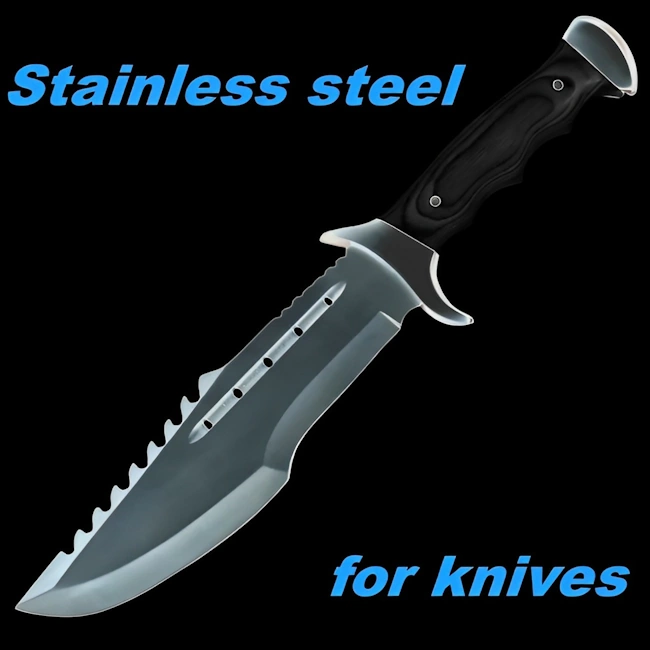
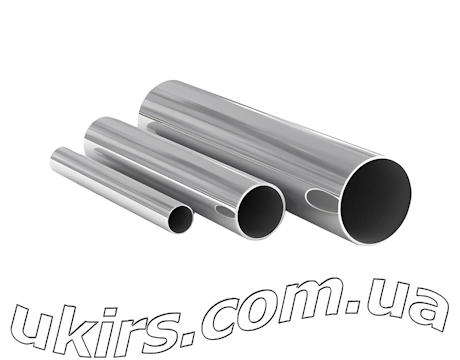 Stainless Steel Round Pipe
Stainless Steel Round Pipe 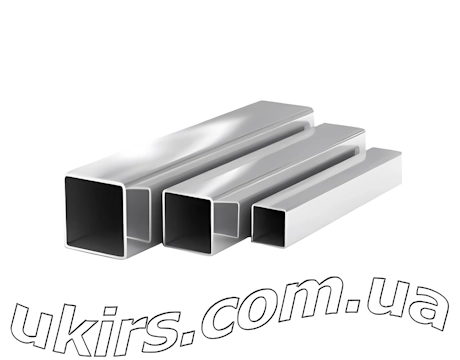 Stainless Steel Square Pipe
Stainless Steel Square Pipe 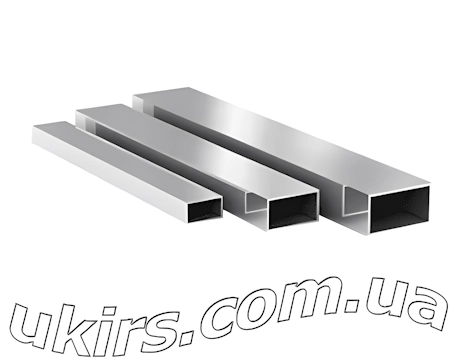 Stainless Steel Rectangular Pipe
Stainless Steel Rectangular Pipe 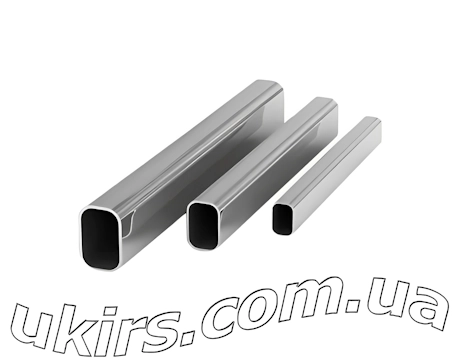 Stainless Steel Oval Pipe
Stainless Steel Oval Pipe 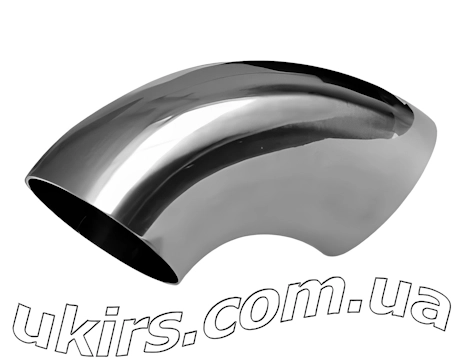 Stainless Steel Elbow
Stainless Steel Elbow 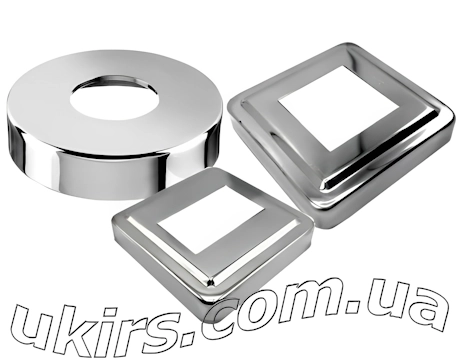 Stainless Steel Decorative Cover
Stainless Steel Decorative Cover 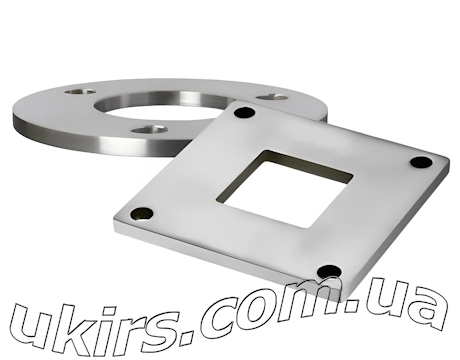 Stainless Steel Flange
Stainless Steel Flange 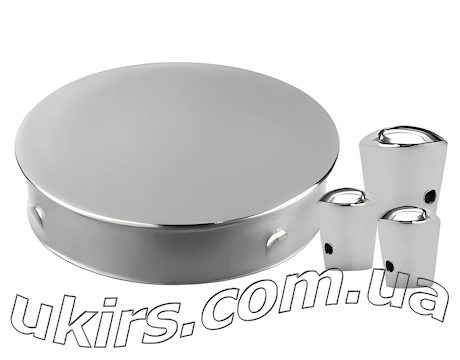 Stainless Steel Plug / Cap
Stainless Steel Plug / Cap 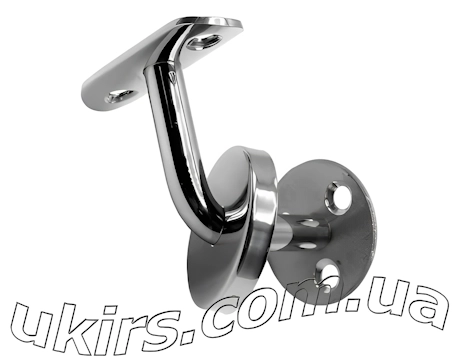 Stainless Steel Handrail Holder
Stainless Steel Handrail Holder